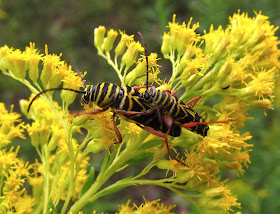Our fall-foliage season is still several weeks away, and the vibrant summer flowers that have lined every roadside and filled every meadow are fading fast. But lots of color can still be found on a woodland walk, as these photos attest, taken today on an hour's stroll through the Skidmore Woods.
New England Aster (Symphyotrichum novae-angliae) is the deepest purple of all our native asters.
Zigzag Goldenrod (Solidago flexicaulis) has broad, sharply toothed leaves on a zigzag stem, and it's one of the very few goldenrods that grow in the shady woods.
Blue-stemmed Goldenrod (Solidago caesia) also blooms in the shady woods, its flowers growing all along the arching stem in the axils of its lance-shaped leaves.
Bright orange berries circle the stems of Orange-fruited Horse Gentian (Triosteum aurantiacum).
Ink-blue berries on hot-pink pedicels hang heavy from the sturdy stalks of Pokeweed (Phytolacca americana).
The porcelain-white berries and vivid pink pedicels of White Baneberry (Actaea pachypoda) stand out in the darkest shade of the woods.
Panicled Dogwood (Cornus racemosa) also has white berries on deep-pink pedicels, a beautiful combination.
Update: I just noticed the Green Shield Bug hiding out below a white dogwood berry. I wonder if it had been dining on that berry that appears half eaten.
Until it bears its bright-red berries, Ginseng (Panax quinquefolius) can hardly be detected among other leafy plants on the forest floor. I always worry that poaching herbalists might now be able to more easily spot it.
The Locust Borer Beetles (Megacyllene robiniae) are as vividly colored as the goldenrod they feed (and frolic!) on.
The Spotted Apatelodes Moth (Apatelodes torrefacta) is about as colorful as a dead dry leaf. Its caterpillar, on the other hand, is an intense lemon yellow. Perhaps its color warns predators that some of those colorful hairs can deliver a stinging venom.
The following two fungi were about the exact opposite of colorful, but it was just their pale translucency that caused them to stand out against the dark background of rotting wood and leaves.
I believe that this coral fungus with its pale cream tips that resemble white flames is Lentaria byssiseda.
These tiny white mushrooms with powdery gray stalks (Marasmiellus nigripes) were scattered like snowflakes all over the forest floor today. They are known to spring up overnight following a heavy rain like the one we had last night. This little cluster would have fit in the bowl of a demitasse spoon.













These are absolutely wonderful pictures, so vivid! I can always count on you for an interesting post about a walk in the woods.
ReplyDelete